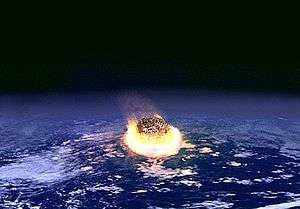Asteroid Terrestrial-impact Last Alert System
The Asteroid Terrestrial-impact Last Alert System (ATLAS) is a proof of concept astronomical survey system for early detection of dangerous asteroids—for ones within a few weeks of impacting Earth. The project was developed at the University of Hawaii with US$5 million funding from NASA.[1]
Deployed in 2015, the automated system provides a one-week warning for a 45 metres (150 ft) diameter asteroid, and a three-week warning for a 120 m (390 ft) one, as long as their radiant is not too close to the Sun.[1] By comparison, the February 2013 Chelyabinsk meteor impact was from an object estimated at 17 m (60 ft) and its radiant's closeness to the Sun put it in the blind zone of an ATLAS-like system.
The system became fully operational at the end of 2015. ATLAS may be expanded geographically to several other locations in both hemispheres to provide continuous coverage.[2] Additionally, ATLAS will look for dwarf planets and supernovae.[1]
Naming
The Last Alert part of the system name refers to the fact that smaller asteroids would not be found in time for potential deflection, but that days or weeks of warning would be provided in order to evacuate a target area. According to ATLAS project lead John Tonry, "that's enough time to evacuate the area of people, take measures to protect buildings and other infrastructure, and be alert to a tsunami danger generated by ocean impacts".[3]
Design and operation
ATLAS will consist of up to eight small telescopes, each fitted with cameras with resolution of 100 megapixels. The first two telescopes are to be sited in the Hawaiian Islands. The telescopes will scan the visible sky twice per night, much more quickly but in much less depth than larger surveying telescope arrays such as University of Hawaii's Pan-STARRS.[1]
NASA's Near Earth Observation Program provided a US$5 million grant, with $3.5 million covering the first three years of design, construction and software development, and the balance of the grant to fund the systems operation for two years following its entry into full operational service in late-2015.[4]
See also
- 1490 Ch'ing-yang event
- 99942 Apophis
- Asteroid impact avoidance
- B612 Foundation
- Gravity tractor
- List of meteor air bursts
- NEOShield
- Spaceguard Foundation
References
- 1 2 3 4 University of Hawaii at Manoa's Institute for Astronomy (18 February 2013). "ATLAS: The Asteroid Terrestrial-impact Last Alert System". Astronomy Magazine. Retrieved 2013-02-22.
- ↑ Atlas: How it works. Asteroid Terrestrial-impact Last Alert System.
- ↑ Clark, Stuart (18 February 2013). "Asteroids and how to deflect them". The Guardian. Retrieved 2013-02-22.
- ↑ Oliver, Chris. ATLAS Project Funded by NASA, Nā Kilo Hōkū (newsletter), Institute for Astronomy, University of Hawaii, No. 46, 2013, p. 1. Retrieved August 2, 2014.
